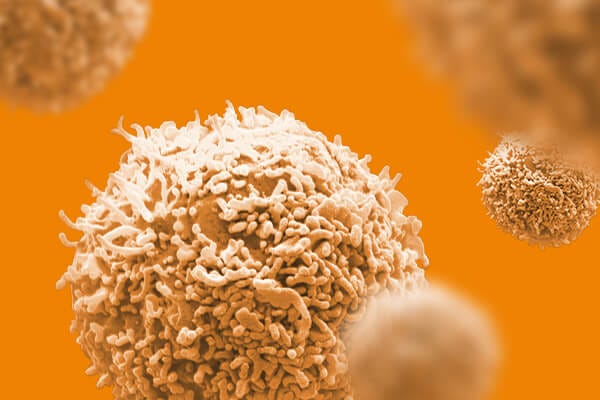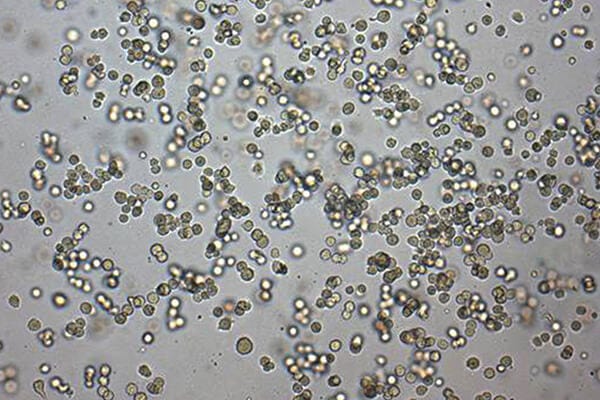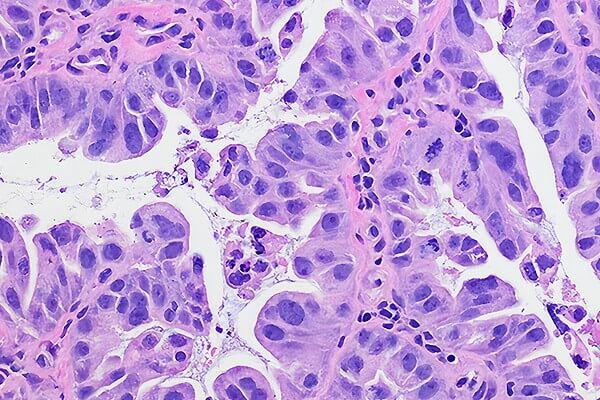Scientific Resources
-
 文献Thirukkumaran CM et al. (JUL 2003) Blood 102 1 377--87
文献Thirukkumaran CM et al. (JUL 2003) Blood 102 1 377--87Reovirus oncolysis as a novel purging strategy for autologous stem cell transplantation.
Hematologic stem cell rescue after high-dose cytotoxic therapy is extensively used for the treatment of many hematopoietic and solid cancers. Gene marking studies suggest that occult tumor cells within the autograft may contribute to clinical relapse. To date purging of autografts contaminated with cancer cells has been unsuccessful. The selective oncolytic property of reovirus against myriad malignant histologies in in vitro,in vivo,and ex vivo systems has been previously demonstrated. In the present study we have shown that reovirus can successfully purge cancer cells within autografts. Human monocytic and myeloma cell lines as well as enriched ex vivo lymphoma,myeloma,and Waldenström macroglobulinemia patient tumor specimens were used in an experimental purging model. Viability of the cell lines or purified ex vivo tumor cells of diffuse large B-cell lymphoma,chronic lymphocytic leukemia,Waldenström macroglobulinemia,and small lymphocytic lymphoma was significantly reduced after reovirus treatment. Further,[35S]-methionine labeling and sodium dodecyl sulfate-polyacrylamide gel electrophoresis (SDS-PAGE) of cellular proteins demonstrated reovirus protein synthesis and disruption of host cell protein synthesis as early as 24 hours. Admixtures of apheresis product with the abovementioned tumor cells and cell lines treated with reovirus showed complete purging of disease. In contrast,reovirus purging of enriched ex vivo multiple myeloma,Burkitt lymphoma,and follicular lymphoma was incomplete. The oncolytic action of reovirus did not affect CD34+ stem cells or their long-term colony-forming assays even after granulocyte colony-stimulating factor (G-CSF) stimulation. Our results indicate the ex vivo use of an unattenuated oncolytic virus as an attractive purging strategy for autologous stem cell transplantations. View Publication -
 文献Johnson JJ et al. (APR 2003) Blood 101 8 3229--35
文献Johnson JJ et al. (APR 2003) Blood 101 8 3229--35Prenatal and postnatal myeloid cells demonstrate stepwise progression in the pathogenesis of MLL fusion gene leukemia.
The steps to leukemia following an in utero fusion of MLL (HRX,ALL-1) to a partner gene in humans are not known. Introduction of the Mll-AF9 fusion gene into embryonic stem cells results in leukemia in mice with cell-type specificity similar to humans. In this study we used myeloid colony assays,immunophenotyping,and transplantation to evaluate myelopoiesis in Mll-AF9 mice. Colony assays demonstrated that both prenatal and postnatal Mll-AF9 tissues have significantly increased numbers of CD11b(+)/CD117(+)/Gr-1(+/-) myeloid cells,often in compact clusters. The self-renewal capacity of prenatal myeloid progenitors was found to decrease following serial replating of colony-forming cells. In contrast,early postnatal myeloid progenitors increased following replating; however,the enhanced self-renewal of early postnatal myeloid progenitor cells was limited and did not result in long-term cell lines or leukemia in vivo. Unlimited replating,long-term CD11b/Gr-1(+) myeloid cell lines,and the ability to produce early leukemia in vivo in transplantation experiments,were found only in mice with overt leukemia. Prenatal Mll-AF9 tissues had reduced total (mature and progenitor) CD11b/Gr-1(+) cells compared with wild-type tissues. Colony replating,immunophenotyping,and cytochemistry suggest that any perturbation of cellular differentiation from the prenatal stage onward is partial and largely reversible. We describe a novel informative in vitro and in vivo model system that permits study of the stages in the pathogenesis of Mll fusion gene leukemia,beginning in prenatal myeloid cells,progressing to a second stage in the postnatal period and,finally,resulting in overt leukemia in adult animals. View Publication -
 文献Rosé L et al. (JUL 2002) Experimental hematology 30 7 729--37
文献Rosé L et al. (JUL 2002) Experimental hematology 30 7 729--37In vitro studies of the combination of imatinib mesylate (Gleevec) and arsenic trioxide (Trisenox) in chronic myelogenous leukemia.
OBJECTIVE: The aim of this study was the preclinical evaluation of imatinib mesylate (Gleevec,formerly STI571) in conjunction with arsenic trioxide (As2O3,Trisenox) for the treatment of chronic myelogenous leukemia (CML). MATERIALS AND METHODS: Tetrazolium-based cell line proliferation assays (MTT assays) were performed to determine the cytotoxicity of As2O3 alone and in combination with imatinib. Cell lines tested in this study were Bcr-Abl-expressing cells (K562,MO7p210,32Dp210) and parental cells (MO7e,32D). Isobologram analysis was performed manually and using the median effect method. In vitro cytotoxicity also was determined in colony-forming assays using CML patient cells. Western blot analysis was performed to detect Bcr-Abl protein levels in K562 cells exposed to As2O3 at graded concentrations. Bcr-Abl protein level kinetics were correlated with cell viability (trypan blue count) and activated caspase-3 detected by flow cytometry. RESULTS: We show additive to synergistic cytotoxicity in Bcr-Abl+ cell lines depending on inhibitory concentrations and cell type. Results obtained by colony-forming assays confirmed the findings in cell line proliferation assays. Flow cytometric detection of activated caspase-3 revealed synergistic activity in K562 cells. Treatment of K562 cells with As2O3 alone led to down-regulation of Bcr-Abl protein within 24 hours,even at low doses. The decline of Bcr-Abl preceded activation of caspase-3 and the loss of viable cells. CONCLUSIONS: Favorable cytotoxicity and proapoptotic activity of imatinib in conjunction with As2O3 and specific down-regulation of Bcr-Abl protein levels by As2O3 in K562 cells indicate that As2O3 in combination with imatinib might be useful for circumventing resistance to imatinib monotherapy. View Publication -
 文献Scappini B et al. (DEC 2001) Clinical cancer research : an official journal of the American Association for Cancer Research 7 12 3884--93
文献Scappini B et al. (DEC 2001) Clinical cancer research : an official journal of the American Association for Cancer Research 7 12 3884--93Effects of signal transduction inhibitor 571 in acute myelogenous leukemia cells.
STI571 is a 2-phenylalaminopyrimidine derivative that inhibits c-abl,Bcr-Abl,and platelet-derived growth factor receptor tyrosine kinases. Recently,inhibition of stem cell factor (SCF)-induced c-kit phosphorylation and cell proliferation by STI571 was reported in the human myeloid cell line MO7e. Because approximately 70% of acute myelogenous leukemia (AML) cases are c-kit positive,we evaluated in vitro effects of STI571 on c-kit-positive cell lines and primary AML blast cells. At concentrations textgreater5 microM,the drug marginally inhibited SCF-independent proliferation of cell lines and most of AML blasts. Treatment of AML cells with cytarabine and STI571 showed synergistic effect at low concentrations. Western blotting analysis documented a distinct band of M(r) 145,000 specific for c-kit in cell lines and in AML samples. There was no correlation between the level of the c-kit expression evaluated by Western blotting and percentage of c-kit-positive blasts as measured by flow cytometry. Neither in cell lines nor in primary AML cells,c-kit autophosphorylation was detectable under standard growth conditions. SCF-induced phosphorylation of c-kit in MO7e cells was inhibited by STI571. In a c-kit-positive AML-4 cell line,as well as in AML samples,c-kit phosphorylation was not induced by SCF exposure,suggesting that in these cases,the receptor could not be functionally activated. In conclusion,with the exception of MO7e,SCF did not induce phosphorylation of c-kit,and cell proliferation was not modulated in the presence of STI571. We did not detect any SCF-independent c-kit phosphorylation in our experimental systems. Consequently,STI571 exerted only a limited inhibitory effect on the cell growth. View Publication
过滤器
筛选结果
类别
- Product Information
- Educational Materials
Show More
Show Less
产品类型
- Instruments and Software 2 项目
Show More
Show Less
产品系列
- STEMprep 2 项目
- ALDEFLUOR 2 项目
- EasySep 4 项目
- MethoCult 44 项目
- RoboSep 1 项目
- StemSpan 14 项目
Show More
Show Less
资源类别
- Brochure 1 项目
- 文献 50 项目
- 视频 1 项目
Show More
Show Less
细胞类型
- B 细胞 182 项目
- Cardiomyocytes 21 项目
- CD4+ 121 项目
- CD8+ 92 项目
- CHO细胞 3 项目
- Endoderm 18 项目
- Endothelial Cells 12 项目
- Epithelial Cells 29 项目
- HEK-293细胞(人胚肾293细胞) 1 项目
- Hematopoietic Cells 22 项目
- Hepatic Cells 13 项目
- HUVEC细胞(人脐静脉内皮细胞) 1 项目
- Mesenchymal Cells 18 项目
- Mesoderm 18 项目
- Neural Cells 89 项目
- NK 细胞 121 项目
- Other Subsets 21 项目
- PSC-Derived 128 项目
- PSC衍生 27 项目
- Regulatory 34 项目
- T Cells 102 项目
- T 细胞 352 项目
- 上皮细胞 106 项目
- 中胚层 1 项目
- 乳腺细胞 74 项目
- 先天性淋巴细胞 23 项目
- 全血 6 项目
- 内皮细胞 8 项目
- 内皮集落形成细胞(ECFCs) 3 项目
- 前列腺细胞 8 项目
- 单核细胞 142 项目
- 多巴胺能神经元 3 项目
- 多能干细胞 1859 项目
- 小胶质细胞 3 项目
- 巨噬细胞 25 项目
- 巨核细胞 8 项目
- 心肌细胞 15 项目
- 成骨细胞 6 项目
- 星形胶质细胞 2 项目
- 杂交瘤细胞 83 项目
- 树突状细胞(DCs) 91 项目
- 气道细胞 73 项目
- 淋巴细胞 33 项目
- 癌细胞及细胞系 130 项目
- 白细胞单采样本 12 项目
- 白血病/淋巴瘤细胞 14 项目
- 真皮细胞 2 项目
- 神经元 165 项目
- 神经干/祖细胞 420 项目
- 神经细胞 6 项目
- 粒细胞及其亚群 76 项目
- 红系细胞 9 项目
- 肌源干/祖细胞 9 项目
- 肝细胞 25 项目
- 肠道细胞 61 项目
- 肾细胞 3 项目
- 肾脏细胞 4 项目
- 肿瘤细胞 11 项目
- 胰腺细胞 12 项目
- 脂肪细胞 6 项目
- 脑肿瘤干细胞 87 项目
- 血小板 4 项目
- 血浆 16 项目
- 血管生成细胞 2 项目
- 调节性细胞 9 项目
- 软骨细胞 7 项目
- 造血干/祖细胞 874 项目
- 间充质基质细胞 13 项目
- 间充质干/祖细胞 156 项目
- 间充质细胞 1 项目
- 骨髓基质细胞 2 项目
- 骨髓瘤细胞 4 项目
- 髓系细胞 116 项目
- 鼠胚胎成纤维细胞 1 项目
- 白细胞 9 项目
- 其它细胞系 5 项目
- 红细胞 10 项目
Show More
Show Less
研究领域


 EasySep™小鼠TIL(CD45)正选试剂盒
EasySep™小鼠TIL(CD45)正选试剂盒





 沪公网安备31010102008431号
沪公网安备31010102008431号